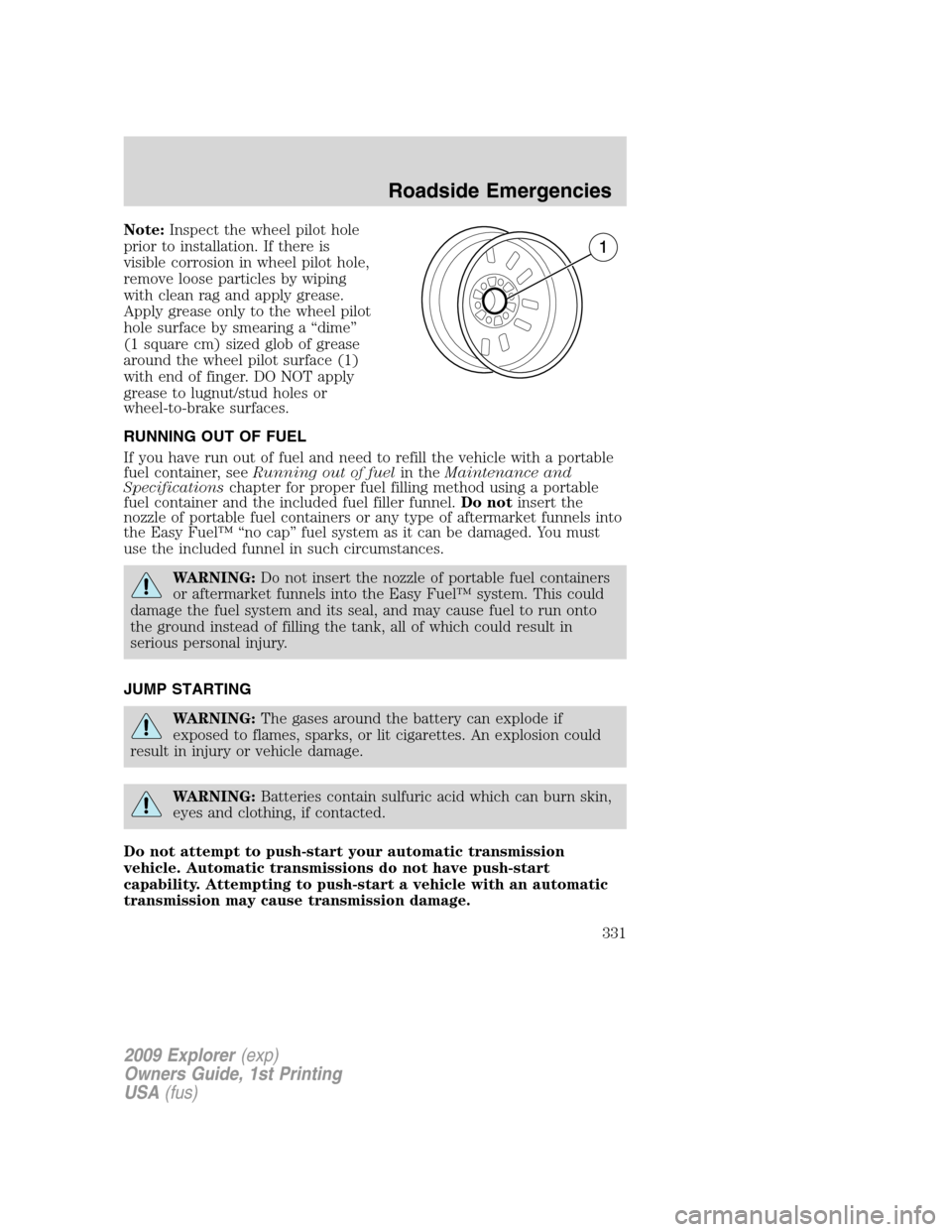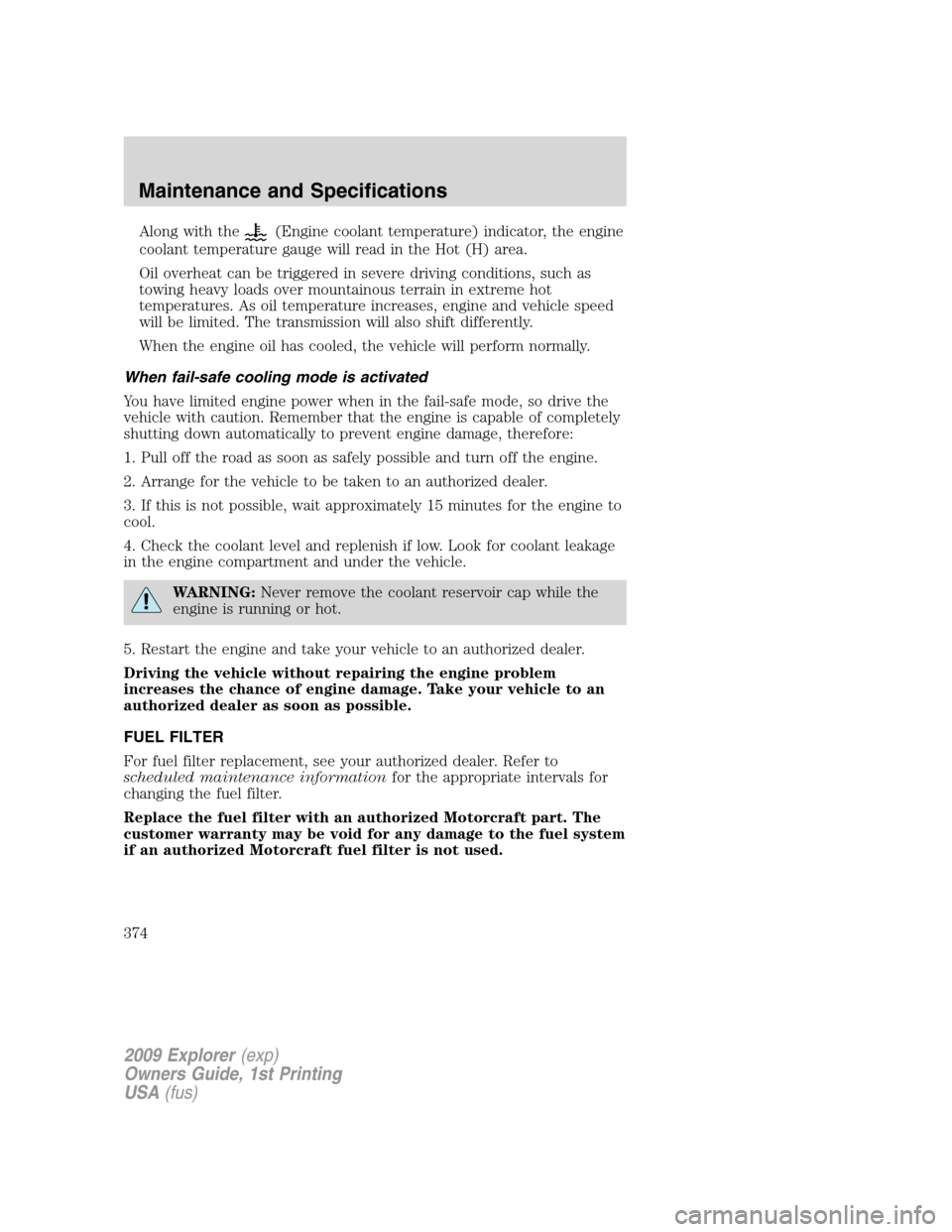Page 331 of 407

Note:Inspect the wheel pilot hole
prior to installation. If there is
visible corrosion in wheel pilot hole,
remove loose particles by wiping
with clean rag and apply grease.
Apply grease only to the wheel pilot
hole surface by smearing a “dime”
(1 square cm) sized glob of grease
around the wheel pilot surface (1)
with end of finger. DO NOT apply
grease to lugnut/stud holes or
wheel-to-brake surfaces.
RUNNING OUT OF FUEL
If you have run out of fuel and need to refill the vehicle with a portable
fuel container, seeRunning out of fuelin theMaintenance and
Specificationschapter for proper fuel filling method using a portable
fuel container and the included fuel filler funnel.Do notinsert the
nozzle of portable fuel containers or any type of aftermarket funnels into
the Easy Fuel™ “no cap” fuel system as it can be damaged. You must
use the included funnel in such circumstances.
WARNING:Do not insert the nozzle of portable fuel containers
or aftermarket funnels into the Easy Fuel™ system. This could
damage the fuel system and its seal, and may cause fuel to run onto
the ground instead of filling the tank, all of which could result in
serious personal injury.
JUMP STARTING
WARNING:The gases around the battery can explode if
exposed to flames, sparks, or lit cigarettes. An explosion could
result in injury or vehicle damage.
WARNING:Batteries contain sulfuric acid which can burn skin,
eyes and clothing, if contacted.
Do not attempt to push-start your automatic transmission
vehicle. Automatic transmissions do not have push-start
capability. Attempting to push-start a vehicle with an automatic
transmission may cause transmission damage.
2009 Explorer(exp)
Owners Guide, 1st Printing
USA(fus)
Roadside Emergencies
331
Page 332 of 407

Preparing your vehicle
When the battery is disconnected or a new battery is installed, the
automatic transmission must relearn its shift strategy. As a result, the
transmission may have firm and/or soft shifts. This operation is
considered normal and will not affect function or durability of the
transmission. Over time, the adaptive learning process will fully update
transmission operation.
1.Use only a 12–volt supply to start your vehicle.
2. Do not disconnect the battery of the disabled vehicle as this could
damage the vehicle’s electrical system.
3. Park the booster vehicle close to the hood of the disabled vehicle
making sure the two vehiclesdo nottouch. Set the parking brake on
both vehicles and stay clear of the engine cooling fan and other moving
parts.
4. Check all battery terminals and remove any excessive corrosion before
you attach the battery cables. Ensure that vent caps are tight and level.
5. Turn the heater fan on in both vehicles to protect from any electrical
surges. Turn all other accessories off.
Connecting the jumper cables
1. Connect the positive (+) jumper cable to the positive (+) terminal of
the discharged battery.
Note:In the illustrations,lightning boltsare used to designate the
assisting (boosting) battery.
+–+–
2009 Explorer(exp)
Owners Guide, 1st Printing
USA(fus)
Roadside Emergencies
332
Page 337 of 407
WRECKER TOWING
Note:Turn off the power running boards (if equipped) prior to
preparing the vehicle for towing. Refer toRunning boardsin theDriver
Controlschapter.
If you need to have your vehicle towed, contact a professional towing
service or, if you are a member of a roadside assistance program, your
roadside assistance service provider.
It is recommended that your vehicle be towed with a wheel lift or flatbed
equipment. Do not tow with a slingbelt. Ford Motor Company has not
approved a slingbelt towing procedure.
If the vehicle’s battery is discharged, refer toAutomatic transmission
operationin theDrivingchapter for directions on how to move the
gearshift lever out of the P (Park) position, for proper towing.
On 4x2 vehicles, it is acceptable to tow the vehicle with the front wheels
on the ground (without dollies) and the rear wheels off the ground.
2009 Explorer(exp)
Owners Guide, 1st Printing
USA(fus)
Roadside Emergencies
337
Page 374 of 407

Along with the(Engine coolant temperature) indicator, the engine
coolant temperature gauge will read in the Hot (H) area.
Oil overheat can be triggered in severe driving conditions, such as
towing heavy loads over mountainous terrain in extreme hot
temperatures. As oil temperature increases, engine and vehicle speed
will be limited. The transmission will also shift differently.
When the engine oil has cooled, the vehicle will perform normally.
When fail-safe cooling mode is activated
You have limited engine power when in the fail-safe mode, so drive the
vehicle with caution. Remember that the engine is capable of completely
shutting down automatically to prevent engine damage, therefore:
1. Pull off the road as soon as safely possible and turn off the engine.
2. Arrange for the vehicle to be taken to an authorized dealer.
3. If this is not possible, wait approximately 15 minutes for the engine to
cool.
4. Check the coolant level and replenish if low. Look for coolant leakage
in the engine compartment and under the vehicle.
WARNING:Never remove the coolant reservoir cap while the
engine is running or hot.
5. Restart the engine and take your vehicle to an authorized dealer.
Driving the vehicle without repairing the engine problem
increases the chance of engine damage. Take your vehicle to an
authorized dealer as soon as possible.
FUEL FILTER
For fuel filter replacement, see your authorized dealer. Refer to
scheduled maintenance informationfor the appropriate intervals for
changing the fuel filter.
Replace the fuel filter with an authorized Motorcraft part. The
customer warranty may be void for any damage to the fuel system
if an authorized Motorcraft fuel filter is not used.
2009 Explorer(exp)
Owners Guide, 1st Printing
USA(fus)
Maintenance and Specifications
374
Page 388 of 407

TRANSMISSION FLUID
Checking automatic transmission fluid
The automatic transmission does not have an underhood transmission
fluid dipstick.
Refer to yourscheduled maintenance informationfor scheduled
intervals for fluid checks and changes. Your transmission does not
consume fluid. However, the fluid level should be checked if the
transmission is not working properly, (i.e., if the transmission slips or
shifts slowly) or if you notice some sign of fluid leakage.
Transmission fluid should be checked and, if required, fluid
should be added by an authorized dealer.
Do not use supplemental transmission fluid additives, treatments or
cleaning agents. The use of these materials may affect transmission
operation and result in damage to internal transmission components.
TRANSFER CASE FLUID (IF EQUIPPED)
WARNING:Turn off the
power running boards, if
equipped, before working under
the vehicle, jacking or placing any
object under the vehicle. Never
place your hand between the
extended running board and the
vehicle. A moving running board
may cause injury.
1. Clean the filler plug.
2. Remove the filler plug and inspect the fluid level.
2009 Explorer(exp)
Owners Guide, 1st Printing
USA(fus)
Maintenance and Specifications
388
Page 394 of 407

Item CapacityFord Part Name or
equivalentFord Part Number / Ford
Specification
Engine oil 4.6L
engine6.0 quarts
(5.7L)Motorcraft SAE
5W-20 Premium
Synthetic Blend
Motor Oil (US)
Motorcraft SAE
5W-20 Super
Premium Motor Oil
(Canada)
2
XO-5W20-QSP (US)
CXO-5W20-LSP12 (Canada) /
WSS-M2C930-A with API
Certification Mark
Automatic
transmission
(5R55S) fluid11.2 quarts
(10.6L)
3
Motorcraft
MERCON�VATF
4
XT-5-QM /
MERCON�V
Automatic
transmission fluid
(6R80)11.2 quarts
(10.6L)
3
Motorcraft
MERCON�LV AT F
4
XT-10-QLV /
MERCON�LV
Rear axle fluid 3.5 pints (1.7L)Motorcraft SAE
75W-140 Synthetic
Rear Axle LubricantX Y-75W140-QL /
WSL-M2C192-A
Front axle fluid
(AWD & 4WD)2.7 pints (1.3L)Motorcraft SAE
80W-90 Premium
Rear Axle LubricantXY-80W90-QL /
WSP-M2C197-A
Power steering fluidFill between the
MIN and MAX
lines on
reservoirMotorcraft
MERCON�VATFXT-5-QM /
MERCON�V
Transfer case fluid
(4WD)1.5 quarts
(1.4L)Motorcraft Transfer
Case FluidXL–12 /
—
2009 Explorer(exp)
Owners Guide, 1st Printing
USA(fus)
Maintenance and Specifications
394
Page 395 of 407

Item CapacityFord Part Name or
equivalentFord Part Number / Ford
Specification
Transfer case fluid
(AWD)1.3 quarts
(1.25L)Motorcraft Transfer
Case FluidXL–12 /
—
Windshield washer
fluid4.2 quarts
(4.0L)Motorcraft Premium
Windshield Washer
ConcentrateZC-32-A /
WSB-M8B16- A2
Fuel tank22.5 gallons
(85.2L)——
1Add the coolant type originally equipped in your vehicle.2Use of synthetic or synthetic blend motor oil is not mandatory. Engine oil need only have the API
Certification mark and meet the requirements of Ford specification WSS-M2C929-A (4.0L) or
WSS-M2C930-A (4.6L).3Indicates only approximate dry-fill capacity. Some applications may vary based on cooler size and
if equipped with an in-tank cooler. The amount of transmission fluid and fluid level should be
checked by a qualified technician.4Use of a dual usage fluid in an automatic transmission requiring MERCON�V may cause
transmission damage. Use of any fluid other than the recommended fluid may cause transmission
damage. Refer toscheduled maintenance informationto determine the correct service interval.
2009 Explorer(exp)
Owners Guide, 1st Printing
USA(fus)
Maintenance and Specifications
395
Page 398 of 407
The Vehicle Identification Number (VIN) contains the following
information:
1. World manufacturer identifier
2. Brake system / Gross Vehicle
Weight Rating (GVWR) / Restraint
System
3. Vehicle line, series, body type
4. Engine type
5. Check digit
6. Model year
7. Assembly plant
8. Production sequence number
TRANSMISSION CODE DESIGNATIONS
You can find a transmission code on
the Safety Compliance Certification
Label. The following table tells you
which transmission each code
represents.
Description Code
Five-speed automatic (5R55S) V
Six-speed automatic (6R80) 6
2009 Explorer(exp)
Owners Guide, 1st Printing
USA(fus)
Maintenance and Specifications
398